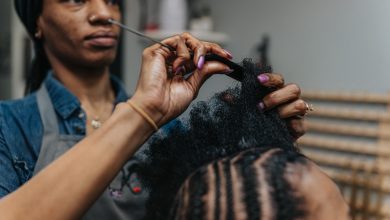Dr. Mona Shahriari’s Tips For Treating Scalp Psoriasis in Black Skin


Can you discuss the challenges faced by people of color in diagnosing and treating scalp psoriasis?
I think there are a lot of challenges that patients with skin of color face, but one of the biggest ones is the social determinants of health. A lot of them cannot get to the right specialist that’s going to properly diagnose their disease, and there are many reasons for that. Sometimes from a geographic standpoint, you may not have access to your specialist, or you don’t have the luxury of taking time off between 8:00 to 5:00 when the doctor’s office is open. So they oftentimes get care in an ER setting where you don’t necessarily have access to a dermatologist who can properly diagnose your psoriasis.
But then to top it all off, some of these individuals actually do make it to a dermatologist’s office, but that dermatologist may or may not have proper training in the diagnosis and treatment of psoriasis in melanin-rich skin. So they may be misdiagnosed, there may be a delay in diagnosis, or they may be undertreated because the disease is being inaccurately graded from a severity standpoint. When you also look at a lot of the textbooks nowadays that are teaching the residents, that are teaching the healthcare professionals, we don’t have enough representation of melanin-rich skin.
Even when you do a quick Google search, if you put psoriasis into Google Images, you have to scroll down quite a ways to find one image with skin of color. And in an era where a lot of patients are Googling their disease, if you don’t see it represented on that first page of Google, you probably don’t think that’s what you have and you’re not going to necessarily seek out care. So, I do think it’s a multifactorial issue, but the important thing is there’s a lot of attention to the nuances of diagnosing and treating psoriasis and skin color, so hopefully, we’re going to make some progress for the future.
What are some common misconceptions or misdiagnoses people of color face regarding scalp psoriasis?
A lot of times my patients with skin of color come in thinking that they have just a fancy form of dandruff or they have a fungal infection of the scalp and they’ve been treated with multiple antifungal medications that haven’t made much progress. And also, eczema is another big one that I get because a very itchy scalp, especially in our patients with darker skin, can be very itchy for them. And typically, you think of eczema, not necessarily psoriasis.
But I think the most important reason why there are so many issues with the diagnosis is when we were taught about what psoriasis looks like, in medical school, it’s supposed to be this red plaque with a silvery scale. However, in melanin-rich skin, red is not the best adjective to use because sometimes that plaque can look violet, it can look dark brown, it can even have the shade of a post-inflammatory lesion. So it’s really important for us to broaden our color palette and what we’re thinking of when we’re treating our patients with skin color because things are not going to look the way we were traditionally taught, and that’s how you make a mistake. That’s how you come up with these other diagnoses that aren’t necessarily correct.
RELATED: Scalp Conditions: Treatments & Causes
Could you discuss the recent study on scalp psoriasis in people of color and its implications?
The Visible Skin of Color study is the first of its kind, a dedicated study looking at psoriasis in individuals with skin of color. And I really think that this was a great step toward diversity, equity, and inclusivity because what it comes down to is, nowadays, there’s a lot of challenges that our patients with skin of color are going to face when they’re getting treatment for their plaque psoriasis, whether it’s on their scalp or their body. And this study not only was trying to figure out what is the effect of a drug like Tremfya on the plaques of psoriasis on the scalp, but also wanted us to understand what are the challenges that our patients with skin of color face when it comes to just access to the system, getting these medications, are there any barriers that we’re unaware of that as clinicians, we need to keep in mind when we’re treating our patients with skin of color.
And in this study, the results were quite amazing. And the majority of patients who had gotten to the primary endpoint, which was almost clear of their scalp psoriasis, the majority of them were actually 100 percent clear, which is reassuring for these patients because after three shots, you have a pretty darn good shot of having your psoriasis just melt away and you can live a healthy, normal life. We also saw a lot of quality of life impacts of the scalp psoriasis on these patients that after they were treated with the medication, that quality of life burden would decrease significantly.
What are some effective strategies for distinguishing between scalp psoriasis and other conditions like dandruff for people of color?
It’s pretty challenging because even as clinicians, sometimes it’s difficult for me to know if it is scalp psoriasis or something else. There are a lot of over-the-counter shampoos that are available, but the problem is when you’re dealing with Afro-textured hair, for example, the shampoos over the counter, you need to use them every day for it to be effective. But when you have that tightly coiled hair,




